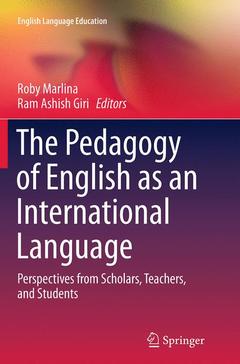The Pedagogy of English as an International Language, 2014 Perspectives from Scholars, Teachers, and Students English Language Education Series, Vol. 1

This volume offers insights in current theoretical discussions, observations, and reflections from internationally and regionally celebrated scholars on the theory and practice of teaching English informed by a new school of thought, English as an International Language (EIL). This volume provides readers (scholars, teachers, teacher-educators, researchers in the relevant fields) with:
Knowledge of the changing paradigm and attitudes towards English language teaching from teaching a single variety of English to teaching intercultural communication and English language variation.
Current thoughts on the theory of teaching English as an international language by internationally-celebrated established scholars and emergent scholars.
Scholarly descriptions and discussions of how English language educators and teacher-educators translate the paradigm of English as an International Language into their existing teaching.
Delineation of how this newly emerged paradigm is received or responded to by English language educators and students when it is implemented. Readers have a unique opportunity to observe and read the tensions and dilemmas that educators and students are likely to experience in teaching and learning EIL.
Foreword.- Chapter One: The Pedagogy of English as an International Language (EIL): More Reflections and Dialogues.- SECTION ONE: Consider Change.- Chapter Two: Teaching English in Asia in non-Anglo cultural contexts: principles of the ‘Lingua Franca Approach’.- Chapter Three: Teaching English as an International Language in Multicultural Contexts: Focus on Australia.- Chapter Four: Teaching and Learning of EIL in Korean Culture and Context.- SECTION TWO: Dimensions of Change.- Chapter Five: English as an International Language and Three Challenging Issues in English Language Teaching in Japan.- Chapter Six: Teaching the target culture in English teacher education programs: Issues of EIL in Vietnam.- Chapter Seven: Implementing EIL paradigm in ELT classrooms: Voices of experienced and pre-service English language educators in Malaysia.- Chapter Eight: Teaching Teachers to teach English as an International Language: a Korean case.- Chapter Nine: The Relocation of Culture in the teaching of English as an International Language.- Chapter Ten: Teaching and assessing EIL vocabulary in Hong Kong.- SECTION THREE: Critical reflections on [Experience of] change.- Chapter Eleven: The Unequal Production of Knowledge in the Sociolinguistics of Englishes.- Chapter Twelve: The Cosmetics of Teaching English as an International Language in Japan: A Critical Reflection.- Chapter Thirteen: “So what do you want us to do?”: A critical reflection of teaching English as an International Language in an Australian context.- Chapter Fourteen: The realities of real English: Voices from those exposed.- Chapter Fifteen: The WEs/EIL paradigm and Japan’s NS propensity: Challenging the ‘friendly face’ of West-based TESOL.- Chapter Sixteen: On Teaching EIL in a Japanese Context: The power within and power without.- Epilogue: Modelling Language Variation.
Date de parution : 09-2016
Ouvrage de 265 p.
15.5x23.5 cm
Date de parution : 07-2014
Ouvrage de 265 p.
15.5x23.5 cm
Thèmes de The Pedagogy of English as an International Language :
Mots-clés :
Challenging Issues in English Language Teaching in Japan; EIL vocabulary in Hong Kong; English Language Teaching in Japan; English Teacher Education Programs; English in Multicultural Contexts; English language educators in Malaysia; Implementing EIL paradigm in ELT classrooms; Issues of EIL and EFL in Vietnam; Teacher education pedagogy perspectives from Australia; Teaching English in Asia in Non-Anglo Cultural Contexts; Teaching and Assessing EIL Vocabulary in Hong Kong; Teaching and Learning of EIL in Korean Culture and Context; WEs/EIL paradigm; West-based TESOL; learning and instruction
